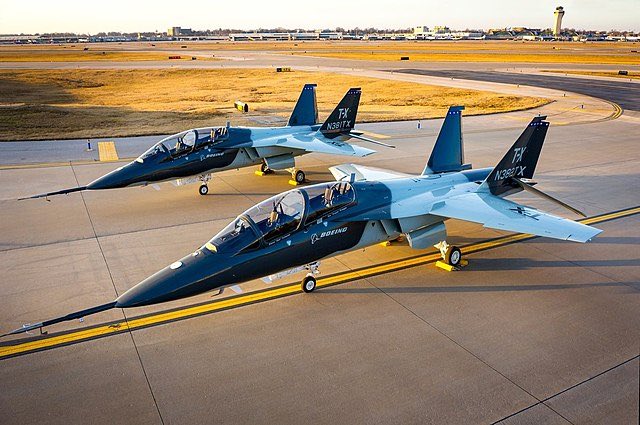T-7 Red Hawk
Summary
| Category | Military Training Aircraft |
| Origin country | 🇺🇸 United States |
| Manufacturer | Boeing-Saab |
| First flight | 20 December 2016 |
| Year introduced | |
| Number produced | 2 units |
| Average unit price | $22 million |
Description
The T-7A Red Hawk is a U.S.-built advanced pilot training system, designed to train the next generation of fighter and bomber pilots. It is a joint project between Boeing and Saab Group and is developed to replace the Northrop T-38 Talon, which has been in service since the 1960s. The T-7A Red Hawk was officially named in September 2019 and is intended to serve the U.S. Air Force as well as potentially other military branches and allied nations. The development program won a contract from the U.S. Air Force in 2018, and the aircraft made its first flight in December of the same year.
The T-7A features a sleek, streamlined design with a twin-tail configuration, which is intended to mimic the appearance and handling characteristics of contemporary front-line fighter aircraft. It employs a General Electric F404 turbofan engine, known for its reliability and efficiency. The aircraft is equipped with modern avionics, including a glass cockpit, that are intended to ease the transition for trainee pilots to more advanced platforms like the F-35 and F-22.
One of the standout features of the T-7A's design is its modularity. It has been engineered in a way that allows for easy upgrades and modifications, be it in the avionics, systems, or even structural components. This was a conscious decision to ensure the aircraft's longevity and adaptability to evolving training needs.
In terms of development timeline, the aircraft's initial concept was fast-tracked through extensive use of digital design and testing methodologies, often referred to as the "Digital Thread." This approach allowed for a more streamlined, efficient development process, culminating in the aircraft's first flight within three years of contract award, a relatively quick turnaround for a military aircraft.
The T-7A Red Hawk is not merely an aircraft but a comprehensive training system, which includes ground-based training and a sophisticated simulator system to provide a holistic training environment. The ground-based systems are designed to closely integrate with the aircraft, providing a seamless transition from classroom to cockpit for trainees.
Operational history
As of 2023, the T-7A Red Hawk has not yet entered operational service with any military branch. The aircraft is in various stages of testing and evaluation with the aim of eventually replacing the T-38 Talon in the U.S. Air Force's pilot training pipeline. The program has reached several milestones, including its first flight in December 2018 and the official naming ceremony in September 2019.
Boeing and Saab have conducted multiple test flights, focusing on the aircraft's aerodynamic performance, avionics systems, and overall reliability. The tests are designed to certify the aircraft for various operational conditions and to validate its capabilities as a training platform.
The U.S. Air Force plans for the T-7A to be the cornerstone of their new pilot training system. The timeline for initial operational capability was targeted for the late 2020s, with the intent to gradually phase out the older T-38 Talon aircraft. The T-7A is also being considered for export to allied nations looking to modernize their own pilot training programs.
Variants
The primary variant under development is the T-7A Red Hawk, focused on training pilots for the U.S. Air Force. This version is designed to be highly modular, allowing for customization and adaptability in training missions.
There had been discussions and conceptual designs for potential variants, although none had reached the production stage by that time. These potential variants could include:
- A light attack version: While not its primary mission, the T-7A's design could potentially be adapted for a light attack role, featuring added hardpoints for munitions and mission-specific avionics.
- Naval variant: There was some speculation about a possible naval version for training U.S. Navy pilots, although no official development had been announced.
- Export version: Given the interest from other countries in a modern, cost-effective training platform, an export variant could be developed to meet the specific needs and requirements of foreign air forces.
- Advanced training or "aggressor" variant: This would be a version of the T-7A equipped with more advanced systems to simulate enemy aircraft in training exercises.
Technical specifications
| Version: T-7A | |
|---|---|
| Crew | 2 members |
| Maximum speed | 1300 km/h (808 mph) |
| Wingspan | 10 m (32.8 ft) |
| Height | 4 m (13.1 ft) |
| Length | 15.2 m (49.7 ft) |
| Service ceiling | 15,240 m (50,000 ft) |
| Empty weight | 3,250 kg (7,165 lbs) |
| Max. takeoff weight | 5,500 kg (12,125 lbs) |
| Climb rate | 170.0 m/s (557.7 ft/s) |
| Powerplant | 1 x turbofan General Electric F404-GE-402 delivering 4990 kgf each |
Current operating countries
| Country | Units | ||
|---|---|---|---|

|
United States | 1 (+350) | |
All operators
